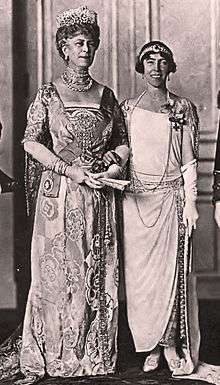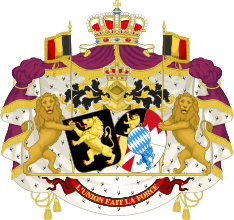Elisabeth of Bavaria, Queen of Belgium
Queen Elisabeth of Belgium (born Duchess Elisabeth in Bavaria; 25 July 1876 – 23 November 1965) was Queen consort of the Belgians as the spouse of King Albert I, and a Duchess in Bavaria by birth. She was the mother of King Leopold III of Belgium and of Queen Marie-José of Italy, and grandmother of kings Baudouin and Albert II of Belgium, and Grand Duchess Joséphine-Charlotte of Luxembourg.
| Elisabeth | |||||
|---|---|---|---|---|---|
 Elisabeth in 1920 | |||||
| Queen consort of the Belgians | |||||
| Tenure | 23 December 1909 – 17 February 1934 | ||||
| Born | Duchess Elisabeth in Bavaria 25 July 1876 Possenhofen Castle, Bavaria, German Empire | ||||
| Died | 23 November 1965 (aged 89) Brussels, Belgium | ||||
| Burial | |||||
| Spouse | |||||
| Issue |
| ||||
| |||||
| House | Wittelsbach | ||||
| Father | Duke Karl-Theodor in Bavaria | ||||
| Mother | Infanta Maria Josepha of Portugal | ||||
| Religion | Roman Catholicism | ||||
Family
Born in Possenhofen Castle, her father was Karl-Theodor, Duke in Bavaria, head of a cadet branch of the Bavarian royal family, and an ophthalmologist. She was named after her father's sister, Empress Elisabeth of Austria, better known as Sisi. Her mother was Maria Josepha of Portugal, daughter of exiled Miguel I of Portugal. Charlotte, Grand Duchess of Luxembourg, Zita, the last Empress of Austria and Queen of Hungary, and Felix of Bourbon-Parma, husband of Grand Duchess Charlotte and brother of Empress Zita, were among Elisabeth's first cousins.
An artist himself, Duke Karl-Theodor cultivated the artistic tastes of his family and Elisabeth was raised with a deep love for painting, music and sculpture. At her father's clinic, where her mother assisted her father as a nurse, Elisabeth obtained exposure to productive labour and to human suffering unusual at that time for a princess.
Married life and queenship




In Munich on 2 October 1900, Duchess Elisabeth married Prince Albert, second-in-line to the throne of Belgium (after his father Prince Philippe, Count of Flanders). Upon her husband's accession to the Belgian throne in 1909, Elisabeth became queen. The city of Élisabethville, today Lubumbashi, in the Congo was named in her honour.
They had first met in 1897 at the funeral of Elisabeth's aunt Duchess Sophie Charlotte in Bavaria, who was also the mother-in-law of Albert's sister Henriette. At the time, Prince Albert was the heir to his uncle Leopold II of Belgium. Albert was the second son of Prince Philippe, Count of Flanders and Princess Marie of Hohenzollern-Sigmaringen, a sister of King Carol I of Romania.
At birth, Albert occupied the third place in the line of succession behind his father and elder brother, Prince Baudouin. The unexpected death of Baudouin in January 1891 immediately raised Albert to prominence within his country. A studious, quiet man, Albert was not the choice of heir that King Leopold II would have relished. As the only living male member of his generation, Albert was guaranteed the Crown of the Belgians upon the King's death. Albert had two sisters who survived into adulthood, Princess Henriette who married Prince Emmanuel of Orléans, and Princess Joséphine Caroline who married her cousin, Prince Karl-Anton of Hohenzollern-Sigmaringen, brother of King Ferdinand I of Romania.
In December 1909, Albert and Elisabeth became King and Queen of the Belgians, following the death of Albert’s uncle, King Leopold II. The new Queen took on a much more public role than her predecessors, getting involved with many charities and organizations, particularly those in the arts and social welfare. She often surrounded herself with famous authors and artists, as well as leading scientists of the day. Her friendly nature, and true care and concern for others, quickly endeared her to the people of Belgium.
When war broke out in 1914, Queen Elisabeth worked with the nurses on the front and helped establish the Symphony Orchestra of the field army. She also travelled to the UK often, under the pretext of visiting her children who were studying there. She was often bringing important messages and information to the British government from her husband and his forces. Following the war, the family made a triumphant return to Brussels and set about to rebuild the nation.
During the First World War, she and the King resided in De Panne. The Queen made herself beloved by visiting the front lines and by sponsoring a nursing unit. Despite her German background, she was a popular queen, perceived as eagerly supporting her adoptive country.
From September 23 to 13 November 1919, the Queen, together with the King and Prince Léopold, undertook an official visit to the United States of America. During a journey in the historic pueblo of Isleta in New Mexico, the King awarded the Order of Léopold to Father Anton Docher.[1] As a memento, the King was given a turquoise cross mounted in silver made by the Tiwa people.[2] Ten thousand people traveled to Isleta for the occasion.

Later years
On February 17, 1934, Albert I died in a mountain climbing accident in the Ardennes of Belgium, near Namur. He was succeeded by their elder son, King Leopold III. Elisabeth withdrew from public life, so as not to hinder the efforts of her daughter-in-law, now Queen Astrid. However, in August 1935, Queen Astrid was killed in a car crash in Küssnacht am Rigi, Switzerland. Queen Elisabeth returned to the public life, doing her best to support her son and his family, and resuming her position as first lady of the land.
Elisabeth lived to see her son become king (but also go into exile and abdicate), her younger son become, effectively, regent of the realm, and her grandson mount the throne.
As queen dowager, she became a patron of the arts and was known for her friendship with such notable scientists as Albert Einstein. During the German occupation of Belgium from 1940 to 1944, she used her influence as queen and German connections to assist in the rescue of hundreds of Jewish children from deportation by the Nazis.[3] When Brussels was liberated, she allowed her palace to be used for headquarters of the British XXX Corps, and presented its commander General Horrocks with its mascot, a young wild boar named 'Chewing Gum'.[4] After the war she was awarded the title Righteous Among the Nations by the Israeli government.
During the 1950s, the Queen evoked controversy abroad by visiting the Soviet Union, China and Poland, trips that prompted some to label her as the "Red Queen".
Queen Elisabeth died in Brussels at the age of 89 on 23 November 1965 from a heart attack. She is interred in the royal vault at the Church of Our Lady of Laeken, Brussels. She was the 1,016th Dame of the Royal Order of Queen Maria Luisa.
Legacy
The city of Lubumbashi in Congo (Kinshasa) was formerly known as "Élisabethville", and it was named in her honor when it was founded in 1910 in what was then the Belgian Congo. It adopted its current name in 1966 when, after six years of wrangling following independence, the regime of Joseph Desire Mobutu began purging The Congo of its colonial-era place names.
The Queen Elisabeth Competition, an international competition for career-starting musicians held in Brussels, is named after her.[5]
Children
- King Leopold III of Belgium, born 3 November 1901, and died at Woluwe-Saint-Lambert on 25 September 1983.
- Prince Charles, Count of Flanders, born Brussels 10 October 1903, and died at Ostend on 1 June 1983.
- Marie-José, Queen of Italy, born Ostend 4 August 1906, and died in Thonex, Switzerland on 27 January 2001.
Titles, styles, honours, and arms

Titles and styles
- 25 July 1876 – 2 October 1900: Her Royal Highness Duchess Elisabeth in Bavaria
- 2 October 1900 – 17 December 1909: Her Royal Highness Princess Albert of Belgium
- 17 December 1909 – 17 February 1934: Her Majesty The Queen of the Belgians
- 17 February 1934 – 23 November 1965: Her Majesty Queen Elisabeth of Belgium
Honours
National honours
.svg.png)
.svg.png)
Foreign honours
.svg.png)
.svg.png)


- Grand Cross of the Netherlands Lion
- Queen Juliana Inauguration Medal


.svg.png)

.svg.png)
- Awards
Arms
 Alliance Coat of Arms of King Albert I
Alliance Coat of Arms of King Albert I
and Queen Elisabeth Royal Monogram of Queen Elisabeth
Royal Monogram of Queen Elisabeth
of Belgium
Ancestry
| Ancestors of Elisabeth of Bavaria, Queen of Belgium | |||||||||||||||||||||||||||||||||||||||||||||||||||||||||||||||||||||||||||||||||||||||||||||||||||||||||||||||||||||||||||||||||||||||||||||||||||||||||||||||||||||||||||||||||||||||||||||||||||||||||||||||||||||||||||||||||||||||||||||||||||||||||||||||||||||||||||||||||||||||||
|---|---|---|---|---|---|---|---|---|---|---|---|---|---|---|---|---|---|---|---|---|---|---|---|---|---|---|---|---|---|---|---|---|---|---|---|---|---|---|---|---|---|---|---|---|---|---|---|---|---|---|---|---|---|---|---|---|---|---|---|---|---|---|---|---|---|---|---|---|---|---|---|---|---|---|---|---|---|---|---|---|---|---|---|---|---|---|---|---|---|---|---|---|---|---|---|---|---|---|---|---|---|---|---|---|---|---|---|---|---|---|---|---|---|---|---|---|---|---|---|---|---|---|---|---|---|---|---|---|---|---|---|---|---|---|---|---|---|---|---|---|---|---|---|---|---|---|---|---|---|---|---|---|---|---|---|---|---|---|---|---|---|---|---|---|---|---|---|---|---|---|---|---|---|---|---|---|---|---|---|---|---|---|---|---|---|---|---|---|---|---|---|---|---|---|---|---|---|---|---|---|---|---|---|---|---|---|---|---|---|---|---|---|---|---|---|---|---|---|---|---|---|---|---|---|---|---|---|---|---|---|---|---|---|---|---|---|---|---|---|---|---|---|---|---|---|---|---|---|---|---|---|---|---|---|---|---|---|---|---|---|---|---|---|---|---|---|---|---|---|---|---|---|---|---|---|---|---|---|---|---|---|
| |||||||||||||||||||||||||||||||||||||||||||||||||||||||||||||||||||||||||||||||||||||||||||||||||||||||||||||||||||||||||||||||||||||||||||||||||||||||||||||||||||||||||||||||||||||||||||||||||||||||||||||||||||||||||||||||||||||||||||||||||||||||||||||||||||||||||||||||||||||||||
References
- Keleher and Chant. The Padre of Isleta. Sunstone Press, 2009, p. 94.
- W.A. Keleher. The Indian sentinel.1920, vol.2. p.23-24
- Élisabeth en Bavière - her activity to save Jews' lives during the Holocaust, at Yad Vashem website
- p.70, Horrocks, Brian, Belfield, Eversley, Essame, H., Corps Commander, Magnum Books, London, 1977
- "Queen Elisabeth Competition: History:1900". cmireb.be. Retrieved 7 December 2019.
- M. & B. Wattel (2009). Les Grand'Croix de la Légion d'honneur de 1805 à nos jours. Titulaires français et étrangers. Paris: Archives & Culture. pp. 21, 424, 611. ISBN 978-2-35077-135-9.CS1 maint: uses authors parameter (link)
- "Hommage de la République française à la Cité liégeoise". Liège (in French). Archived from the original on 19 April 2015. Retrieved 17 October 2018.
- Kawalerowie i statuty Orderu Orła Białego 1705-2008, 2008, s. 300
- Dziennik Personalny M.S.Wojsk. Nr 13 z 8.06.1922 r.
- "Real orden de Damas Nobles de la Reina Maria Luisa". Guía Oficial de España (in Spanish). 1928. p. 236. Retrieved 9 May 2020.
External links

- Newspaper clippings about Elisabeth of Bavaria, Queen of Belgium in the 20th Century Press Archives of the ZBW
- Portraits of Elisabeth of Bavaria, Queen of Belgium at the National Portrait Gallery, London
Elisabeth of Bavaria, Queen of Belgium Born: 25 July 1876 Died: 23 November 1965 | ||
| Belgian royalty | ||
|---|---|---|
| Vacant Title last held by Marie Henriette of Austria |
Queen consort of the Belgians 1909–1934 |
Succeeded by Astrid of Sweden |